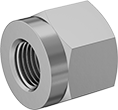How to Identify and Measure Fittings
Pipe size is an industry designation, not the actual size. View information about how to measure threaded and unthreaded pipe and pipe fittings.
More
High-Pressure Nipples for Compressed Gas
Commonly used in high-pressure welding applications, these nipples connect your tank to the inlet of a pressure regulator. One side has a threaded pipe end and the other side has a rounded end that sits inside a threaded nut (sold separately) so you can make a threaded connection.
316 stainless steel nipples have excellent corrosion resistance.

- Maximum Pressure: See table
- Maximum Temperature: 120° F
Regulator Connection | ||||||
|---|---|---|---|---|---|---|
| For Number (Max. Pressure) | Pipe Size | Thread Type | Lg. | For Use With | Each | |
316 Stainless Steel—Tighten With Wrench | ||||||
| CGA 330 (3,000 psi @ 72° F) | 1/4 | NPT | 2" | Boron Trifluoride, Carbonyl Sulfide, Hydrogen Bromide, Hydrogen Chloride, Hydrogen Iodide, Hydrogen Sulfide, Methyl Bromide, Silicon Tetrafluoride, Sulfur Tetrafluoride | 00000000 | 000000 |

- Maximum Pressure: See table
- Maximum Temperature: 120° F
| Number | Gender | Thread Size | Thread Type | Thread Direction | Max. Pressure | For Use With | Each | |
316 Stainless Steel | ||||||||
|---|---|---|---|---|---|---|---|---|
| CGA 330 | Female | 0.830"-14 | NGO | Left Hand | 3,000 psi @ 72° F | Boron Trifluoride, Carbonyl Sulfide, Hydrogen Bromide, Hydrogen Chloride, Hydrogen Iodide, Hydrogen Sulfide, Methyl Bromide, Silicon Tetrafluoride, Sulfur Tetrafluoride | 000000000 | 000000 |
Nuts for High-Pressure Nipples for Compressed Gas
Slide a high-pressure hose nipple for compressed gas into one of these nuts to connect a pipe to the inlet of a pressure regulator. They are also known as CGA (Compressed Gas Association) nuts and inlet nuts.
Brass nuts have good corrosion resistance and are softer than 316 stainless steel nuts, so they're easier to thread together.
Nuts with left-hand threads are identified with a notch.
Note: Nuts have a CGA, BS, or DIN number that corresponds to a specific type of gas. Choose a nut with the same number as your tank and other system components.

- Maximum Pressure: See table
- Maximum Temperature: 120° F, except DIN 477 No. 9: 250° F
| Number | Thread Size | Thread Type | Thread Direction | Max. Pressure | For Use With | Each | |
Brass | |||||||
|---|---|---|---|---|---|---|---|
| CGA 330 | 0.830"-14 | NGO | Left Hand | 3,000 psi @ 72° F | Boron Trifluoride, Carbonyl Sulfide, Hydrogen Bromide, Hydrogen Chloride, Hydrogen Iodide, Hydrogen Sulfide, Methyl Bromide, Silicon Tetrafluoride, Sulfur Tetrafluoride | 000000000 | 000000 |

























